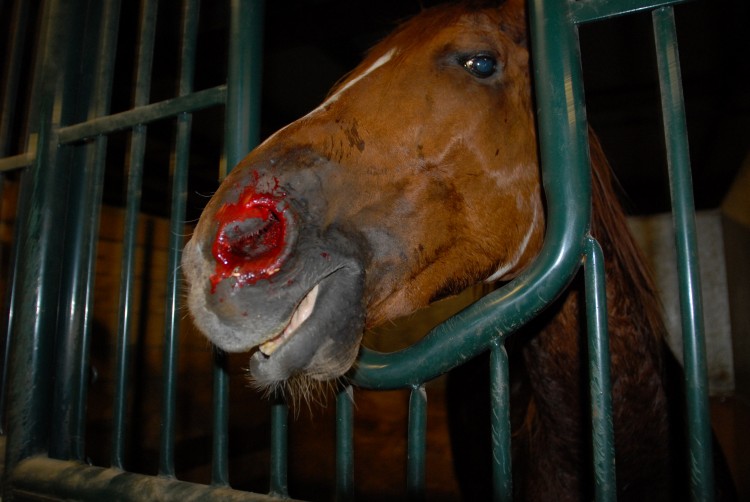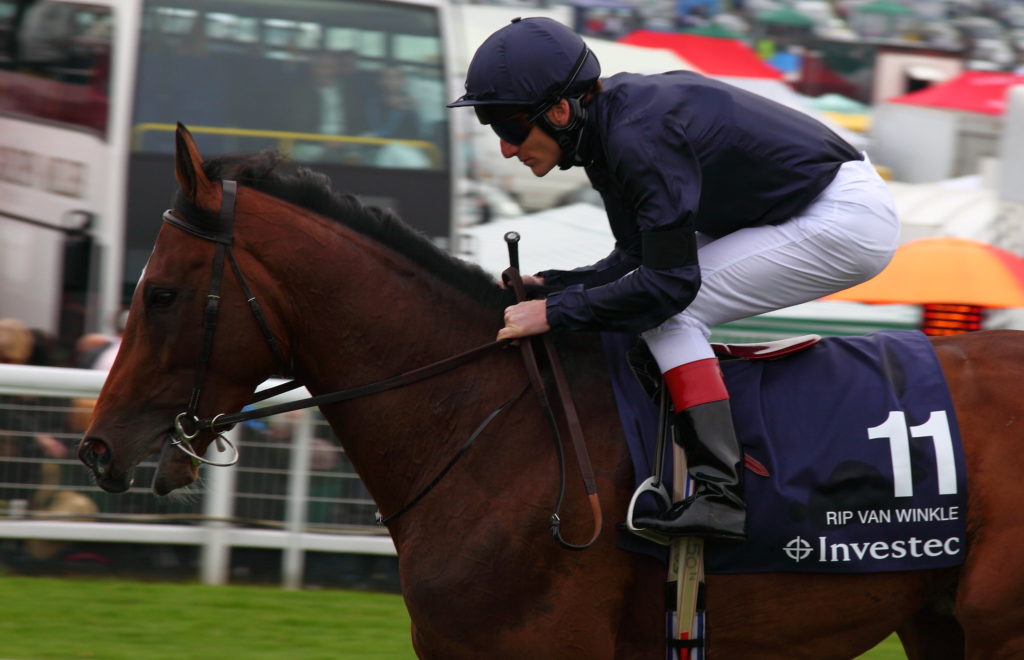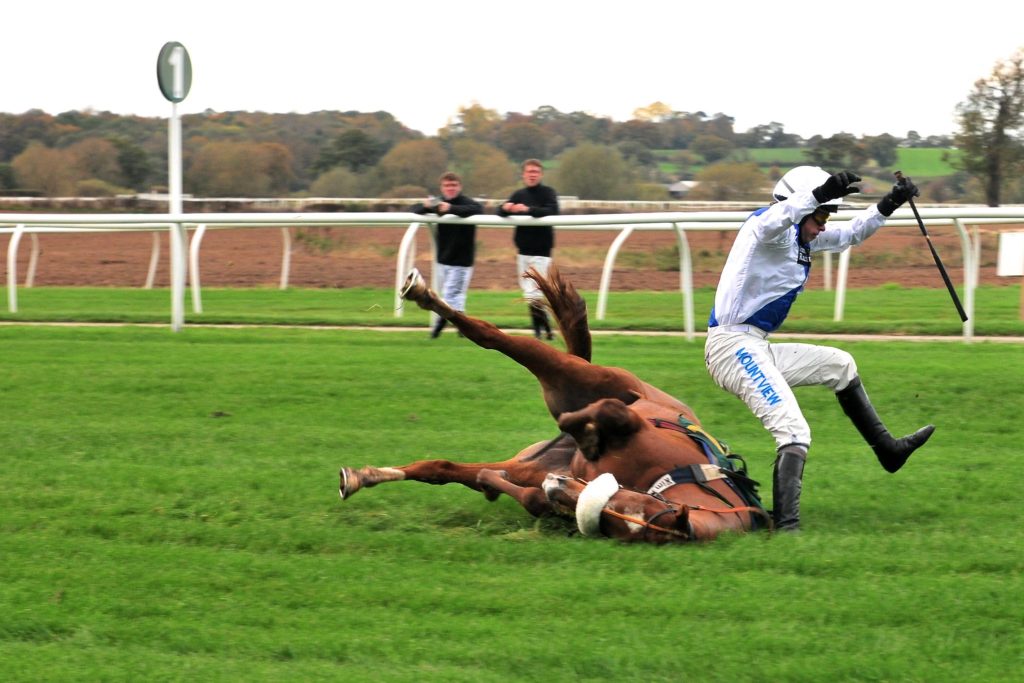Horse racing’s regulatory body in the United Kingdom, the British Horseracing Authority (BHA) sanctions the use of the whip by jockeys for two purposes: to keep rider and mount safe, and for “encouragement.”
Animal Aid is calling for the removal from the rules of the second purpose: encouragement. The whip could then be used only for safety, and as we show below, there are very few occasions when it is needed for that purpose.
“Encouragement”
So-called encouragement is defined by the BHA as ensuring that the horse is focused and concentrated so that “it performs at its best.” In other words, the horse is being beaten in the belief that whipping can make a horse win a race. Of course, the other jockeys may be trying to do the same thing, but only one horse can win, apart from an occasional dead-heat, so it is a zero-sum game. So, even before we offer our evidence that whipping doesn’t even work for the jockeys that use it, it is logically clear that using the whip for encouragement is pointless overall. It is also, as we show later, extremely cruel.
Does “encouragement” work?
Animal Aid’s 2004 report, “A Hiding to Nothing,” analysed 161 races involving 285 jockeys and 1,500 horses to see how well horses ran when whipped, compared with those whipped less or not at all. The results showed that use of the whip is actually counter-productive in terms of producing winners. The report also found that horses who are whipped may be driven off a true line, placing them and other horses in danger, and even causing them to fall.
A 2011 University of Sydney report, “An Investigation of Racing Performance and Whip Use by Jockeys in Thoroughbred Races,” also concluded that whipping does not improve performance. Its authors concluded, “On average, they achieved highest speeds when there was no whip use, and the increased whip use was most frequent in fatigued horses. That increased whip use was not associated with significant maintenance of velocity as a predictor of superior race placing at the finish of the race.”
Animal Aid’s 2015 report, “Abuse and Lose,” analysed all breaches of the whip regulations during July of that year. It showed that whipping invariably happens in the final stages of hotly contested races, as 75 percent of the breaches of the whip rules were by the first and second jockeys at the finish of a race. In 75 percent of breaches, there was a distance of half a length or less between horses, down to the smallest of margins.
The jockey is trying to squeeze every last drop of effort from what is often an exhausted animal, and thereby aims to improve the chances of winning–even though the horse’s added exertion can lead to injuries, falls, bleeding lungs and heart attacks.

The 2015 report also showed that whipping a horse generally reduces rather than improves a jockey’s chances of finishing in a higher position. In fact, the figures presented indicated that a horse is more likely to lose a race or not run on to a higher finishing position if the rules are breached.
Is the whip cruel?
British racing’s defense of the whip was outlined in the BHA’s 2011 review of its use. However, an independent critical analysis of the BHA review found that it “does not present any evidence to support the statement that the whip does not cause pain.” In fact, “despite it being a claimed priority for the industry, there appears to have been no scientific research funded to investigate the welfare impacts of whip use.”
Whips used in racing have a padded area at the end but they also have a long, hard handle that comes into physical contact with the horse–not only on the quarters but also down the shoulder and neck. Independent research from Australia examined 15 races frame-by-frame to study in detail what happens when a horse is whipped. The results were alarming. 75% of whip strikes made contact with the side of the stomach (flanks); 83% left visible indentations and, most shocking of all, while the modern whip has a padded end section, in 64% of all whip strikes that were studied, the hard, unpadded shaft made contact with the horse. It is reasonable to assume that a similar analysis would produce equivalent results in Britain.

Whip advocates claim that horses do not feel the whip because of the adrenaline provoked by the race and because they have thicker skin. However, according to a study by Dr. Lydia Tong, from the Elizabeth MacArthur Agricultural Institute in New South Wales: “We found that, actually, there seem to be more nerve endings in that piece of horse skin, which was a big surprise. In addition, this idea that horses’ skin is thicker and so they are more resistant to pain was a little bit debunked because, in fact, the very top layer of the skin, which lies over the pain-sensing fibers was actually thinner in horses than it was in people. So, it was only a comparison of the two, one person and one horse at this stage, but it really gave us a lot of food for thought.”
Some horses are whipped so hard that it leaves welts.
Safety
Some argue that whips help jockeys to steer a straight line, thereby preventing accidents. Evidence suggests the reverse can be true. According to the BHA itself, a decrease in permitted whip strikes has resulted in a reduction in cases of “interference,” a classic indicator of horses drifting from their true line.
As long as racing continues, whip use should be permitted only in response to a genuine issue of safety, and in those rare cases, its use should be sparing. It is because “encouragement beatings” are currently allowed that jockeys feel justified in deploying the whip so routinely.

The rules
There are rules about how many times a jockey can whip a horse. Currently, the maximum is seven times in a Flatrace and eight times in a Jumprace.( The rules had been made tougher in 2011, but following a rebellion by jockeys, the industry softened its approach. However, these limits are often exceeded.
In 2018, there were 548 breaches of the whip by 269 jockeys, compared with 524 breaches by 264 riders in 2017. In 2016, Animal Aid recorded 470 breaches by 246 jockeys, making 2018 the third year in a row that the number of breaches and the number of jockeys breaking the rules increased.
Decisions on whether to apply sanctions for whip misuse are a matter for “stewards’ discretion.” Because of this, it is unclear how many breaches go unpunished. Sanctions, when applied, typically amount to a two-day ban on riding. Breaking the whip rules in racing does not affect placement or (in most cases) prize money.
The BHA presides over a system characterised by lax rules, even laxer penalties, and a large measure of “discretion” enjoyed by race-day stewards as to whether or not rule breaking jockeys should be punished. All these failings must be remedied. However, even if the rules were never broken, the whip would be still be cruel, and its use for “encouragement” would still be unjustified.

Is it practical to ban the whip?
In 1982, Norway effectively banned the whip in horse racing. The rules stipulate: “Use of the whip will only be tolerated when a dangerous situation occurs, situations which can be of danger to the jockey’s own mount or to competitors, or if the horse is obviously hanging badly, or is trying to duck out.”
In addition, “hands and heels” races, where less experienced jockeys ride, carrying a whip but not using it, already take place at certain meetings in Britain.
Clearly, a ban is perfectly practical and could be introduced in Great Britain.
Public opinion
In a 2018 YouGov poll, 68% of respondents said they opposed the use of the whip in racing. When only including those who expressed a view, this figure rose to 83%.
Conclusion
A ban on the use of the whip for “encouragement” would prevent a great deal of unjustifiable animal cruelty. Using the whip for encouragement means that animals are being beaten, before a paying public, for self-gain on the part of the jockey and his “connections.” Race horses are the only animals who can be beaten in public in the course of a “sporting” event. Other animals are protected from such treatment.
Animal Aid opposes horse racing because of its exploitation of its primary asset, the race horse. Of course, we know that an end to horse racing is some way off, but we believe that a ban on the whip for all but safety purposes is feasible now. It has been demonstrated to work in Norway and in “hands and heels” races; it would be popular with the public; it would prevent some falls; and, most importantly of all, it would prevent a shocking amount of cruelty and brutality to horses.
Citizens of Great Britain, ask your Member of Pariament to support a ban on the whip in horse racing!
Featured image: onlookers watch a horse race in the UK. Note the use of whips. Image credit Tom Blackwell, CC BY-SA 2.0.





